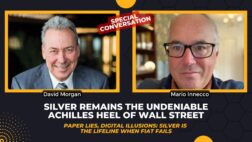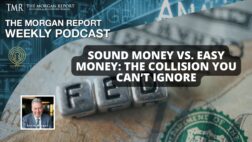Richard (Rick) Mills
Ahead of the Herd
As a general rule, the most successful man in life is the man who has the best information
Trade imbalances – deficits and surpluses – between nations are one of the major reasons for financial crises. Countries become trapped in a vicious spiral – they accumulate debt because they are sustaining a trade deficit, the bigger their debt grows year after year, the harder it becomes to generate a trade surplus.
Only the countries with a trade surplus have any room to manipulate policy, there’s very little debtor nations can do.
In 1942-1943 John Maynard Keynes formulated a solution. His answer was to “persuade” the creditor nations to spend their surplus money back into the economies of debtor nations.
His proposed creation, the International Clearing Union, would be a global bank and issue its own currency, the Bancor, a supranational currency to be used in international trade as a unit of account exchangeable with national currencies at fixed rates of exchange.
The bancor would be used to measure a country’s trade deficit or trade surplus. Every country would have an overdraft facility equivalent to half the average value of its trade over the past five years. Any country racking up a trade deficit of more than half of its bancor overdraft allowance would be charged interest on its account, have to reduce the value of its currency and prevent export of capital.
On the other side of the trade balance any nation with a trade surplus (a bancor credit balance) more than half the size of its overdraft facility would be charged interest, have to increase the value of its currency and permit export of capital.
Keynes proposed penalty for missed compliance on nations with a trade surplus was severe, it was designed to give nations with a surplus a powerful incentive to erase it and in doing so automatically clear other nations’ deficits. By the end of the year a countries credit balance could not exceed the total value of its permitted overdraft, if it was the surplus would be confiscated.
“It would be difficult to exaggerate the electrifying effect on thought throughout the whole relevant apparatus of government … nothing so imaginative and so ambitious had ever been discussed.” Lionel Robbins, British economist
Britain adopted Keynes’s solution as its official negotiating position for the Bretton Woods conference in 1944 – the United Kingdom wanted to introduce the Bancor after the Second World War ended.
The US was vehemently opposed to the idea…
“We have been perfectly adamant on that point. We have taken the position of absolutely no.” Harry Dexter White, head of the US delegation at Bretton Woods
The Bretton Woods conference established the U.S. dollar as the worlds reserve currency.
“Lord Keynes was right … the world will bitterly regret the fact that his arguments were rejected.” Geoffrey Crowther in 1944, editor Economist magazine
On April 13 2010, the Strategy, Policy and Review Department of the IMF published a comprehensive report entitled “Reserve Accumulation and International Monetary Stability.” The IMF report advocates the adoption of a true global currency, the “Bancor” (so named in honor of Keynes), administered by a global central bank…
“A global currency, bancor, issued by a global central bank would be designed as a stable store of value that is not tied exclusively to the conditions of any particular economy. As trade and finance continue to grow rapidly and global integration increases, the importance of this broader perspective is expected to continue growing.”
The Triffin Dilemma
When a national currency also serves as an international reserve currency conflicts between a country’s national monetary policy and its global monetary policy will arise.
“In October of 1959, a Yale professor sat in front of Congress’ Joint Economic Committee and calmly announced that the Bretton Woods system was doomed. The dollar could not survive as the world’s reserve currency without requiring the United States to run ever-growing deficits. This dismal scientist was Belgium-born Robert Triffin, and he was right. The Bretton Woods system collapsed in 1971, and today the dollar’s role as the reserve currency has the United States running the largest current account deficit in the world.
By “agreeing” to have its currency used as a reserve currency, a country pins its hands behind its back. In order to keep the global economy chugging along, it may have to inject large amounts of currency into circulation, driving up inflation at home. The more popular the reserve currency is relative to other currencies, the higher its exchange rate and the less competitive domestic exporting industries become. This causes a trade deficit for the currency-issuing country, but makes the world happy. If the reserve currency country instead decides to focus on domestic monetary policy by not issuing more currency then the world is unhappy.
Becoming a reserve currency presents countries with a paradox. They want the “interest-free” loan generated by selling currency to foreign governments, and the ability to raise capital quickly, because of high demand for reserve currency-denominated bonds. At the same time they want to be able to use capital and monetary policy to ensure that domestic industries are competitive in the world market, and to make sure that the domestic economy is healthy and not running large trade deficits.
Unfortunately, both of these ideas – cheap sources of capital and positive trade balances – can’t really happen at the same time.” How The Triffin Dilemma Affects Currencies, investopedia.com
“Providing reserves and exchanges for the whole world is too much for one country and one currency to bear.” Henry H. Fowler, U.S. Secretary of the Treasury
In the wake of the financial crisis of 2007–2008, Zhou Xiaochuan the governor of the People’s Bank of China, said that a national currency is unsuitable as a global reserve currency because the Triffin dilemma is today, the root cause of global economic disorder.
In a speech titled “Reform the International Monetary System” Zhou argued that part of the reason for the original Bretton Woods system breaking down was the refusal to adopt Keynes’ bancor. Calling Keynes’s bancor approach “farsighted” Xiaochuan proposed strengthening existing global currency controls through the IMF by the adoption of International Monetary Fund (IMF) special drawing rights (SDRs) as a global reserve currency.
When Special Drawing Rights were originally created in 1969 one SDR was defined as having a value of 0.888671 grams of gold, equal to the value of one US dollar at that time. After the breakdown of the Bretton Woods system the SDR was redefined in terms of a basket of four currencies.
From January 1 2011, the IMF has determined that the four currencies will be assigned revised weights based on their roles in international trade and reserves.
Due to varying exchange rates, the relative value of each currency varies continuously and thus the value of the SDR fluctuates. The IMF fixes daily the value of one SDR in terms of US dollars based on the exchange rates of the constituent currencies.
The following is the current breakdown of the components of an SDR on Thursday April 5th 2012….
U.S. Dollar: 41.9 percent
Euro: 37.4 percent
Yen: 9.4 percent
Pound: 11.3 percent
“A limitation of the SDR as discussed previously is that it is not a currency. Both the SDR and SDR-denominated instruments need to be converted eventually to a national currency for most payments or interventions in foreign exchange markets, which adds to cumbersome use in transactions. And though an SDR-based system would move away from a dominant national currency, the SDR’s value remains heavily linked to the conditions and performance of the major component countries.” IMF report “Reserve Accumulation and International Monetary Stability”
A Single Global Currency: Is it Feasible? By S. Korra, B. Gopal and S. Gollapalli
“For almost 2,500 years, countries across the world have experienced multicurrency foreign exchange (FX) transactions and its erratic currency fluctuations. The daily turnover in currency markets rose to $3.2 trillion, which was more than 10 times the world GDP. Daily volumes of cross-currency swaps grew by 281% between 2004 and 2007. International corporations were participating more actively in FX market. The US dollar remained the prominent currency in the FX market covering two-fifths of daily transactions. Emerging market currencies were also gaining equal significance on the FX front with 20% of all transactions by April 2008.
Turnover of foreign exchange options and cross-currency swaps more than doubled to $0.3 trillion per day. Though the multicurrency FX market stated a surge of 71% in volume since 2004, it was associated with various costs.
Transactions costs in currency trading were very huge at $400 billion in 2007. Frequent speculations in currency trading resulted in currency fluctuations and in extreme cases led to currency crises. On the contrary, these expensive costs in forex transactions would not be considered in the 3-G world (a Global Monetary Union, with a Global Central Bank and a Single Global Currency – Rick). The 3-G world is the implementation of a single global currency to be managed by a Global Central Bank within a Global Monetary Union. The successful examples were the euro and the dollar.
Moreover, the number of currencies declined to 147 from 159 in the early 21st century. With the implementation of a single global currency huge transaction costs would be saved. There would not be any currency fluctuations and currency risks while dealing in the FX market.”
During a trip to China, International Monetary Fund director Dominique Strauss-Kahn said the days of one country’s currency as the global benchmark are numbered, globalization demands a new global currency that provides representation for the growing importance of a variety of major economies.
“If we are to have a truly global economy, a single world currency makes sense.” Paul Volcker, former Governor of the Federal Reserve Board
Economist Robert A. Mundell says that the creation of a global currency is “a project that would restore a needed coherence to the international monetary system, give the International Monetary Fund a function that would help it to promote stability, and be a catalyst for international harmony. The benefits from a world currency would be enormous. Prices all over the world would be denominated in the same unit and would be kept equal in different parts of the world to the extent that the law of one price was allowed to work itself out. Apart from tariffs and controls, trade between countries would be as easy as it is between states of the United States.”
The Council on Foreign Relations (whose founding members included J.P. Morgan, John D. Rockefeller, Paul Warburg, Otto Kahn, and Jacob Schiff – the same people who had engineered the establishment of the Federal Reserve System) 2007’s article “The End of National Currency” advanced the idea of a global wide currency restructuring. After examining the European Monetary Union it turned to the prospects for monetary unions in North America, South America and East Asia. Regional Monetary Integration emphasizes “the economic and institutional requirements for successful monetary integration, including the need for a single central bank in the case of a full-fledged monetary union and the corresponding need for multinational institutions to safeguard the bank’s independence and assure its accountability.”
Of course this is only a follow up to numerous articles written earlier, such as the CFR journal, Foreign Affairs for July/August 1999. In the opening paragraph of his essay, From EMU to AMU?: The Case for Regional Currencies, Zanny Beddoes of Britain’s The Economist pronounces: “By 2030 the world will have two major currency zones – one European, the other American. The euro will be used from Brest to Bucharest, and the dollar from Alaska to Argentina, perhaps even Asia.”
How important, how widespread and far reaching is the Council on Foreign Relations (CFR)?
“Since 1934 almost every United States Secretary of State has been a CFR member; and ALL Secretaries of War or Defense, from Henry L. Stimson through Richard Cheney…nearly ALL presidential candidates have been CFR members. President Truman, who was not a member, was advised by a group of “wise men,” all six of whom were CFR members, according to Gary Allen. In 1952 and 1956, CFR Adlai Stevenson challenged CFR Eisenhower.
CFR candidates for president include George McGovern, Walter Mondale, Edmund Muskie, John Anderson, and Lloyd Bentsen. In 1976 we had Jimmy Carter, who is a member of the Trilateral Commission, created by David Rockefeller and CFR member Zbigniew Brzezinski with the goal of economic linkage between Japan, Europe, and the United States, and: “…managing the world economy…a smooth and peaceful evolution of the global system.
We have also had (though his name strangely disappears from the membership list in 1979) CFR director (1977-79) George Bush, and last but not least, CFR member Bill Clinton.” William Blase, The Council on Foreign Relations (CFR) and The New World Order
President Obama has surrounded himself with CFR members ie Susan E. Rice, is a prominent member of the Council On Foreign Relations and serves as the U.S. Permanent Representative to the United Nations and is a member of President Obama’s Cabinet. Rice will lead the U.N. Security Council and is considered a leading contender for secretary of state if Obama wins a second term
The Bank for International Settlements (BIS) – established in 1930 and self described as the central and the oldest focal point for coordination of global governance arrangements is, in reality, the central bank for the world’s central banks and is the one true authority in terms of ‘global governance’ – has publicly endorsed a global currency.
Conclusion
With a global government not yet in place how will the process of a global currency be accomplished? The process is already well established (and unrecognized by most) with the advancement of regional currencies such as the Euro, SUCRE (South America), floating the idea of the AMERO (US, Canada and Mexico), the Franc of the African Financial Community, an Asian currency and a Arabian Gulf regional currency.
Once 147 national currencies are five or so regional currencies, with most of the world’s population involved, it’s a logical step down to one global currency built around the regional currencies.
It isn’t if we get a global currency, it’s when, the only question being will gold play a part?
The Dream of a World Currency, Interview of Tommaso Padoa-Schioppa by Alberto Orioli
“AO: Thus the lesson for the future is a single currency, as China is asking for?
TPS: As a former central banker, I think that when you talk about global standards, you should first think about monetary standards and then about legal ones, because that is a functional economic fact, even though it rests on a legal basis. In other words, I do think this crisis poses the problem of a new international monetary standard. Its absence, and the absence of the discipline that it would impose are one of the deep reasons of the present crisis.
AO: Once the currency was pegged to gold…
TPS: If that peg still existed, in the last few years the countries that were accumulating big external deficits – such as the United States – should of had to convert a part of it into gold; the consequent scarcity of gold reserves would have obliged them to change their course.”
Today no country is on a gold standard and all currencies are fiat. If a future fiat global currency were to be put in place without full, or at least a hefty partial gold backing, then we’d simply be repeating Bretton Woods – the 1944 US dollar failed reserve currency experiment – except it’d be on a much grander scale.
A future 3-G world, and a re-introduction of gold into the global monetary system, should be on all our radar screens. Is it on yours?
If not, maybe it should be.
Richard (Rick) Mills
rick@aheadoftheherd.com
www.aheadoftheherd.com
If you’re interested in learning more about the junior resource and bio-med sectors please come and visit us at www.aheadoftheherd.com
Site membership is free. No credit card or personal information is asked for.
***
Richard is host of Aheadoftheherd.com and invests in the junior resource sector. His articles have been published on over 400 websites, including: Wall Street Journal, SafeHaven, Market Oracle, USAToday, National Post, Stockhouse, Lewrockwell, Uranium Miner, Casey Research, 24hgold, Vancouver Sun, SilverBearCafe, Infomine, Huffington Post, Mineweb, 321Gold, Kitco, Gold-Eagle, The Gold/Energy Reports, Calgary Herald, Resource Investor, Mining.com, Forbes, FNArena, Uraniumseek, and Financial Sense.
***
Legal Notice / Disclaimer
This document is not and should not be construed as an offer to sell or the solicitation of an offer to purchase or subscribe for any investment.
Richard Mills has based this document on information obtained from sources he believes to be reliable but which has not been independently verified; Richard Mills makes no guarantee, representation or warranty and accepts no responsibility or liability as to its accuracy or completeness. Expressions of opinion are those of Richard Mills only and are subject to change without notice. Richard Mills assumes no warranty, liability or guarantee for the current relevance, correctness or completeness of any information provided within this Report and will not be held liable for the consequence of reliance upon any opinion or statement contained herein or any omission.
Furthermore, I, Richard Mills, assume no liability for any direct or indirect loss or damage or, in particular, for lost profit, which you may incur as a result of the use and existence of the information provided within this Report.



